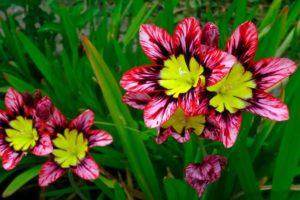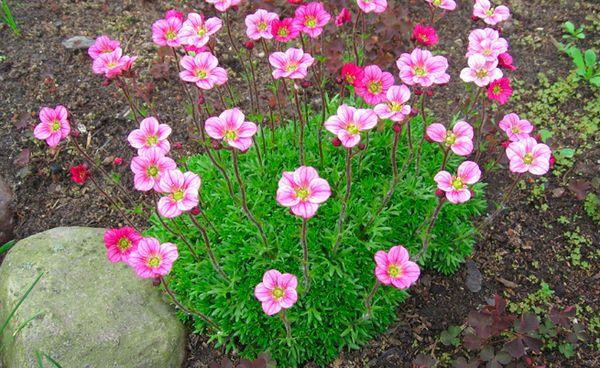Planting and caring for saxifrage in the open field, a description of the best varieties
An unusual representative of the flora is saxifrage. Its delicate small flowers look spectacular among stones and crevices. High vitality, unpretentiousness, durability makes the culture popular among gardeners. Knowing all the nuances and subtleties of planting and caring for a saxifrage, you can easily decorate any area with these amazing flowers.
General description of saxifrage
The saxifrage is presented in the form of a herbaceous perennial, the height of which ranges from 5 to 70 cm. The bushes are decorated with leaves of various shapes. It is appreciated by gardeners for the foliage of a dark green color with a blue, silver, bluish tint.
The flowers are medium-sized, five-petaled, regular star-shaped. There are solitary, but often collected in small inflorescences in the form of a panicle. Pleases with long flowering of white, yellow, pink flowers.
The growing season begins in April, and in the second decade of May, the plant begins to bloom, taking the form of a bright carpet. Stays in this outfit for about a month.
Popular varieties and varieties
The saxifrage family has 200 species. Of these, the following varieties are the most popular.
- Soddy saxifrage. The flower is a dense turf of rosettes with dissected leaves. Flowering is short, only 3-4 weeks, which is observed in June.
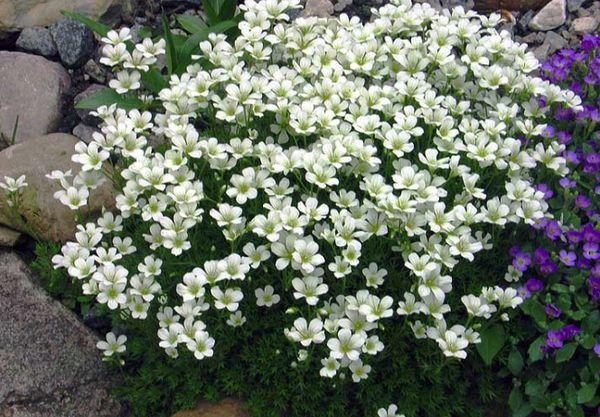
Gardeners prefer the following varieties:
- Rose-kenigen;
- Flamingo;
- Triumph;
- Purplemantel.
- Arends' saxifrage. The flower pleases with bright green color during the season. Its foliage forms a continuous carpet, the height of which is up to 15 cm. It fascinates with its flowering in late spring. Among the common varieties of Anders:
- Sleeping Beauty;
- RedCap;
- Peter Pan;
- Saxifrage;
- Snow carpet;
- Floral Carpet;
- Highlander.

- Saxifrage paniculata. The flower is valued for its gray leaves, covered with white limescale teeth along the edge, as well as beautiful rosettes 5-6 cm in diameter. Pleases with flowering in June, July. The varieties that this species boasts:
- Macocha;
- Balcana minima.
- Wicker saxifrage. It has round, hairy green leaves with light stripes. Forms a rosette, from which many layering departs, which form new rosettes at the ends.
- Saxifrage is round-leaved. Bushes have petiolate leaves in the shape of a circle. In the first days of summer, white flowers are seen on arrows up to 40 cm long, the petals of which are decorated with purple dots.
- Saxifrage mossy. The bush is distinguished by creeping shoots, covered with oblong green leaves. The edges of the leaf plate are cut into thin strips, which makes the dense pillow look like a thicket of moss. The plant is decorated with flowers of a yellow-white color up to 6 cm in length.
- Saxifrage shadow. The bush up to 20 cm in height has solid green leaves in the shape of an oval, which are covered with purple stains. In July, paniculate inflorescences begin to bloom, which are adorned with white small flowers. Their core is purple in color. The most common forms of shady saxifrage are:
- Variegata;
- Aurapunctata;
- Elliotis Variet;
- Purple mantle.
These varieties and varieties of saxifrage can improve the appearance of any area.
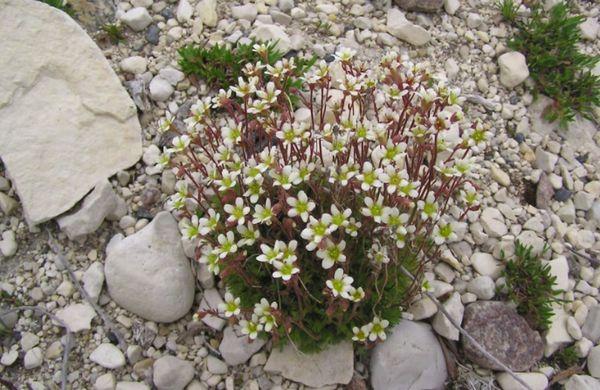
The specifics of growing flowers
In order for the saxifrage to attract attention with its high decorativeness, it is necessary to properly plant. This procedure will not cause difficulties even for novice gardeners. The secret to successfully growing saxifrage is to create conditions as close as possible to its natural habitat.
Time and place
Saxifrage is not a capricious culture, but when determining the place of landing, it is important to take into account its natural preferences. When placing a flower garden, you need to know that the flower loves shady places where it is protected from the scorching sun. Ideally, trees and shrubs will grow nearby.
An important factor in the cultivation of saxifrage is good drainage. Stagnant water can be detrimental to flowers, so you need to consider in advance where the perennial will grow. A good solution would be to plant a flower in crevices between stones or on a slope, while additionally watering during the dry season.
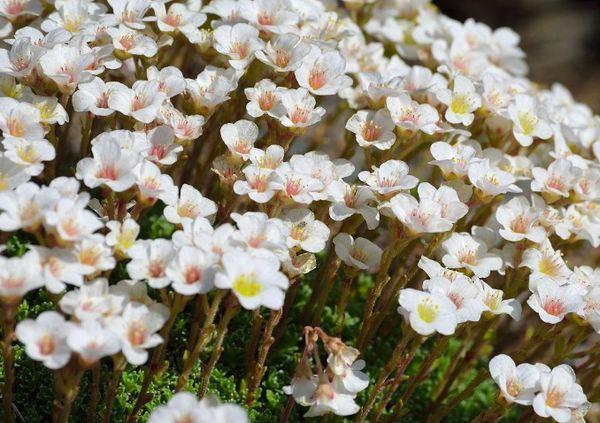
Saxifrage seedlings are advised to be planted in June, when the air and soil will have a temperature of 18-20 degrees.
Soil preparation
Saxifrage takes root without problems on soils of medium fertility. But since it needs limestone, it is better to enrich the soil with crushed limestone. The ideal soil for a crop should be equipped with substances such as gravel, clay, sand, peat, humus. Also, soil preparation includes the addition of superphosphates along with organic matter. It is recommended to lay out a rock garden near the bushes using stones, this will protect the roots from the sun and retain moisture.
Before planting, dig up the soil, loosen it, remove large stones. The day before planting the seedlings, moderate watering of the future flower bed.
Planting instructions
To plant a plant, you need to adhere to the following procedure:
- Make holes at a distance of 10 cm.
- Place the seedlings in the center of the hole.
- Pour the soil around the stem and tamp a little.
- Drizzle over the edge of the hole.
Will delight the flowering saxifrage after a year.In one place, a ground cover plant can grow for 5-6 years, then it needs to be transplanted.

Saxifrage care
In order for flowers to attract attention with their decorativeness, you need to surround them with care.
Soil and fertilizers
Feed plants only with formulations containing minerals. Fertilize for the first time after 7 days, then 2 times a month. Nutrients should be added to the water when watering. At the time of flowering and in winter, stop feeding.
Watering and moisture
Saxifrage requires moderately moist soil. When the soil dries up, the flower will die, therefore, in dry weather, it is recommended to spray the leaves. This will give the saxifrage a spectacular look.
Wintering
Saxifrage is characterized by resistance to frost, but young immature specimens of rare varieties are best covered for the winter. To do this, in the fall, before the first frosts, the planting must be covered using dry foliage or spruce branches.
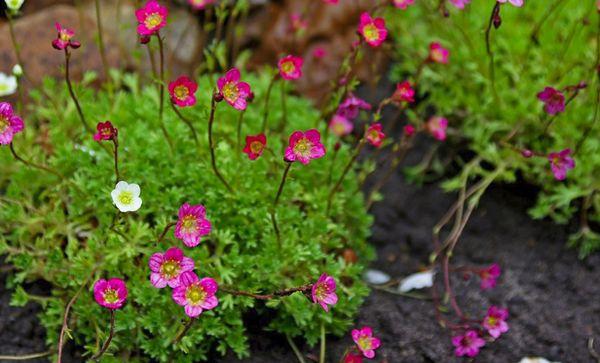
Disease and pest control
The saxifrage shows resistance to diseases and pests.But with illiterate care, mistakes when watering and fertilizing, the crop can become vulnerable to infections and parasites.
| DISEASES | |||
| Name | Sign | Control measures | |
| Powdery mildew
| It appears as a mealy, whitish bloom | Removing infected leaves and treating the plant with a systemic fungicide | |
| Rust | The disease can be diagnosed by the formations of various shapes and sizes that have appeared, but when they crack, a rusty powder always spills out, which is a spore of the fungus | Treatment with a solution of soap and copper sulfate | |
| Decay of roots | With excessive watering and poor-quality drainage, the root system begins to rot | Removal of rotten parts of the roots. For prophylaxis, treat with fungicidal agents | |
| Pests | |||
| Spider mite
| The appearance of marble spots on the leaves. As a result, drying and twisting of the sheet plate | Organize optimal air humidity and treat with soapy water | |
| Green aphid | The appearance of a sticky black bloom on foliage, stems indicates the appearance of aphids | Spray bushes with insecticides | |
| Thrips
| Insects that feed on flowers and shoots. The appearance of small colorless spots on the leaves signals an invasion of thrips. | Treat with insecticides or resort to folk remedies - tincture of pepper, tobacco | |
Breeding culture
You can dilute the culture by seeds, dividing the bush and cuttings:
- Growing from seeds. Sow in spring using special seedling boxes. Seed material should not be covered, but lightly sprinkled with sand. Cover with glass to build a miniature greenhouse. Seedlings are formed in 2-3 weeks. A month later, the first real leaf will be formed. In open soil, sprouts can be planted when the outlet appears, this mainly happens next spring.
- By dividing the bush. To do this, choose a powerful bush and disconnect additional sockets and shoots with roots and foliage, which are planted in the shade and irrigate and loosen the soil around them throughout the summer season. In the spring, after wintering, plant the plants in a permanent place.
- Propagation by cuttings. There are crop types that form long lateral shoots in June. They need to be cut and planted in loose, moist soil, shaded from above. During the summer period, the cuttings will take root and form medium-sized rosettes, which are covered for the winter using foliage.
With any method of reproduction, saxifrage bloom is observed in the 2nd year after planting in a permanent place.
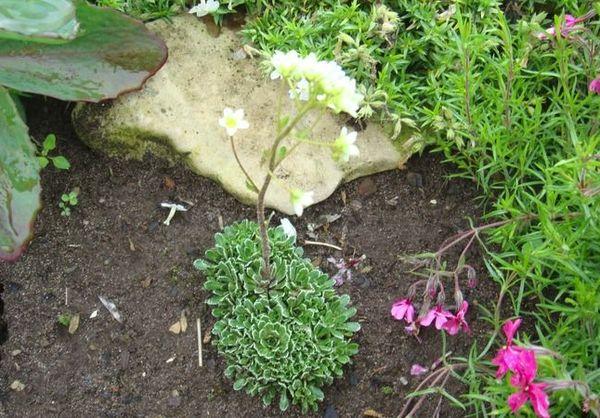
Possible growing difficulties
The only difficulty that gardeners have when breeding saxifrage is the loss of decorativeness due to overgrowth. Since the regrown shoots lose their leaves, which are located closer to the ground and the soil is visible through them. Therefore, caring for the culture, attention must be paid to the renewal of the bushes and their division using cuttings. Also, so that the plant does not lose decorativeness, faded flowers must be broken off along with the peduncle at the base of the turf.
Saxifrage in landscape design
The plant takes pride of place in landscape design because of its spectacular appearance, adaptability to any climatic conditions, the ability to be in the neighborhood with various flowering crops, and low growth of trees.
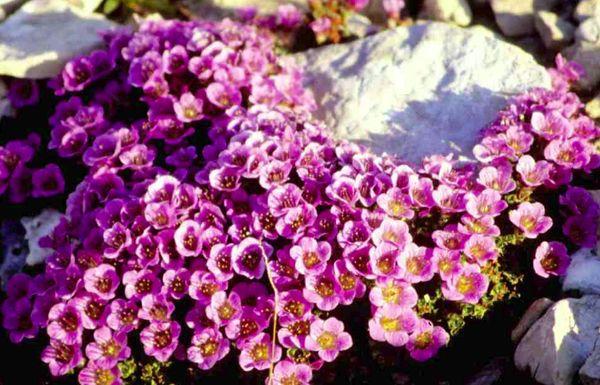
The saxifrage at the time of flowering will revive the rockery and add zest to the rock garden. The attractiveness of the culture increases due to its good compatibility with many garden plants. A picturesque flower garden can be obtained by planting irises, muscari, phlox next to the saxifrage. Tall species are best used as curbs.
Observing simple rules for planting and caring, you can find an approach to this amazing flower. And he, feeling cared for, will begin to actively grow and develop, delighting with magnificent flowering.
